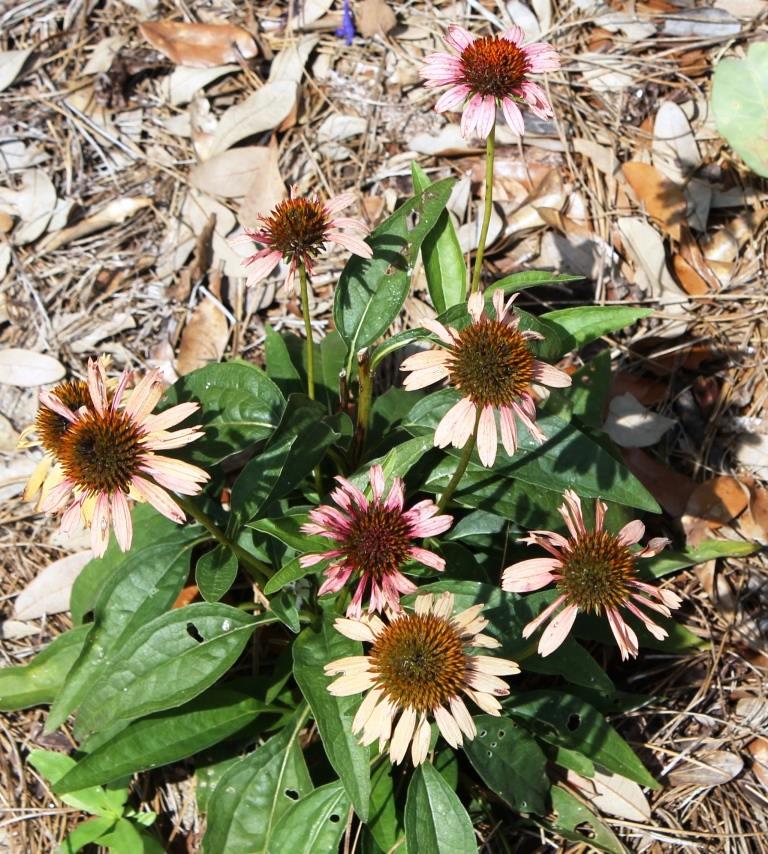
by Matthew Orwat | Nov 20, 2015
 Although it seems like summer outside, especially with such warm weather the week before Thanksgiving, winter temperatures will be coming. Possibly sooner rather than later. Perennials that are meant to die to the ground each winter look ugly and decayed after the first frost. Faced with such unattractive plants, most gardeners are inclined to cut them to the ground right away. That action might be a mistake.
Although it seems like summer outside, especially with such warm weather the week before Thanksgiving, winter temperatures will be coming. Possibly sooner rather than later. Perennials that are meant to die to the ground each winter look ugly and decayed after the first frost. Faced with such unattractive plants, most gardeners are inclined to cut them to the ground right away. That action might be a mistake.
Many perennials, such as hibiscus species, hydrangea, salvia species, firebush (Hamelia patens), rudbeckia, echinacea, lantana and others still have a large amount of starch stored in their branches, even after the first frost. Although it is very tempting to remove these unattractive reminders of the beautiful spring gardening season, it is better to wait to allow the starch to translocate (move) down to the root system. The time that this takes varies by plant species, but can be as late as February.
To determine if there is “life” left in those burned and singed stems, just scratch off the top layer of the stem. If any nutrients remain in the stem, it will be green or yellow where the scratch was made. If it is brown and dead, it is safe to prune the perennial back.
If you can stand to wait, allow those unsightly stalks to remain until February. If they contain any plant nutrients this will give the plant some energy during the winter months. This is not possible in every situation, but following this practice will bring stronger flowering perennials next season!

by Matt Lollar | Nov 18, 2015
Yaupon hollies (Ilex vomitoria) are evergreen, provide great fall/winter color, and can adapt to numerous landscape situations. They are also very durable and can survive extreme drought.
Characteristics
Yaupon hollies are dioecious, meaning male and female flowers are produced on separate plants and berries are only produced on female plants. Flowers are creamy white, but not showy on both male and female plants and berries can range in color from red to yellow depending on cultivar. The plants are favored by wildlife – pollinators are attracted to the flowers and birds love the berries.
Yaupon hollies are native plants with a number of different cultivars available at plant nurseries. ‘Jewel’ is a cultivar that produces an ubundance of red berries and ‘Aureo’ produces yellow berries. ‘Nana’, a dwarf, compact male cultivar is an excellent replacement for boxwoods. Large growing cultivars can grow to 15 to 25 feet tall and can be shaped as trees or left as large shrubs. ‘Folsom’s Weeping’ and ‘Pendula’ are two weeping cultivars that can be utilized as dramatic specimen trees.
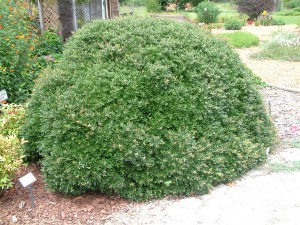
Dwarf Yaupon hollies will naturally form a mound without pruning.
Credit: Beth Bolles, UF IFAS Extension Escambia County
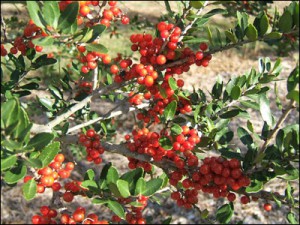
Yaupon holly fruit and foliage. Photo courtesy UF/IFAS.
Plant Care
Yaupon hollies prefer to be planted in full to partial sun. It is important to note that they are drought tolerant and require a site with well-drained soil. Because only the female plants produce berries, it is best to purchase plant material when plants contain berries in late fall and winter. Yaupon hollies spread readily by vegetative sprouts. Sprouts should be pruned down to the soil line 2 – 3 times per year. They do not have many disease or insect problems, but scale, leaf miners, mites, and aphids can sometimes be a problem.
Fun Facts
The leaves of the yaupon holly contain a higher caffeine content than any other plant native to North America. The Seminole Indians would purposely brew a concentrated “Black Drink” tea to induce vomiting and diarrhea for believed purification. Southerners utilized the caffeine in the leaves during the Civil War. If the leaves are steeped for a short period, a black tea or coffee substitute can brewed. A related species of holly (Ilex paraguariensis) from Brazil is used to make a drink called Yerba Mate, which is as popular in South America as coffee is in North America.
For more information on yaupon hollies, please visit the publication located at this link https://edis.ifas.ufl.edu/st311.
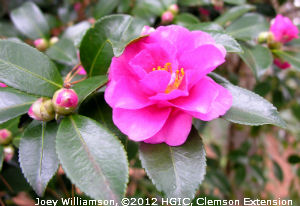
by Sheila Dunning | Nov 18, 2015

Camellia sasanqua ‘Kanjiro’ at the South Carolina Botanical Garden
Camellia sasanquas begin blooming this month. Their three-inch diameter blossoms of pink, white, rose or red displayed over glossy, dark green foliage will come into their full glory in November. This robust and stylish aristocrat of the garden is often passed by in favor of its familiar cousin, Camellia japonica. While it’s true that the “japonicas” have larger flowers, Camellia sasanqua has just as many endearing attributes. Like the japonicas, sasanquas have been selected and hybridized into dozens of forms that vary immensely in flower color, size and shape. With a variety of growth habits from dwarf and spreading to narrow and upright, their ability to thrive in part sun or shade, sasanquas are one of the most versatile landscape plants.
Sasanquas bear profusions of flowers in fall and early winter depending on cultivar and location. In general they blossom before Camellia japonica. Sasanquas have mature heights that range from 4-15 ft. The taller cultivars are typically trimmed up as small trees. Other cultivars remain shrubby and limited in height. Their small foliage makes them suitable subjects for formal pruning, although they are quite attractive when allowed to grow naturally. Several sasanqua varieties are ideal for creating dramatic espaliers when trained on fences and walls. Like other cool weather bloomers, sasanquas bloom over a much longer period than most spring and summer plants with buds opening over a three-month period. The blossoms shatter easily and create colorful carpets of petals on the ground, adding to their garden impact. Even when not in bloom the sasanquas make a statement with their beautifully glossy, rich green leaves that excel at providing backdrops for garden neighbors.

Camellia ‘Vernalis Yuletide’ at the South Carolina Botanical Garden

Camellia sasanqua ‘Shishi Gashira’ at the South Carolina Botanical Garden
Sasanqua camellias are native to China and Japan. They prefer rich organic acid soils (the same as azaleas and gardenias). Provide plants with organic mulch such as leaf litter or shredded bark. Broken shade is preferred but sasanquas will tolerate more sun if watered well. Consistent watering is important to continuous blooming. If the experience drought conditions the buds will dry and fall without opening.
Select sasanqua varieties based on what you want them to do in your garden. ‘Shishi-Gashira’ is a dwarf, low spreading plant that is suited well for foundation plants and container specimens. Other compact varieties include the more upright ‘Yuletide’ whose fiery red blossoms are accented with bright yellow stamens and the double rose ‘Bonanza’ which begins flowering in September with flowers that rival the japonica varieties in size and form. If you need larger and faster growing plants for hedges, screens or small specimen tree, consider the white ‘Snow on the Mountain’, double pink ‘Pink Snow’ or pale, shell pink ‘Jean May’. ‘Kanjiro’ and ‘Daydream’ are vigorous upright pink varieties whose single flowers are fragrant.
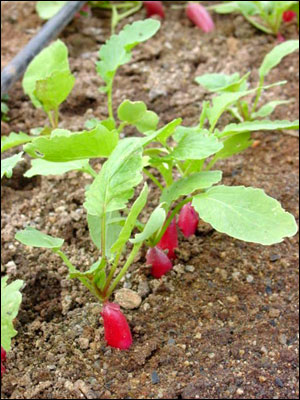
by Matthew Orwat | Nov 13, 2015

Radishes ready to harvest. Image Credit, UF / IFAS Gardening Solutions
Floridians are lucky, in that they are able to grow many vegetables throughout the winter months. If a fast growing, quick producing vegetable is desired, nothing is faster than a radish. Radishes can develop from seed to mature root in 20-30 days, and can be planted any time between September and March. The cooler months of October to February are even better since radishes do not develop the “hot” flavor when grown in cooler temperatures. There is less risk of that occurring during the cooler months of fall and winter.
Radishes should be direct seeded in the garden at a depth of 0.25 inches. They should be seeded 1 inch apart, with rows 6 inches apart. It is important that they not be crowded since the edible root portion will not form properly unless the plants are given plenty of space. Once plants emerge, thin them to about 3 inches apart.
At planting, plenty or organic matter and fertilizer should be incorporated in the bed. If soil is not well-drained garden in a raised bed. Avoid fertilizing once the seeds have germinated. Make sure to provide uniform irrigation and a weed free environment.
Harvest should take place when the radishes are ready (20-30 days), but fairly young to ensure a mild tasting root.
For more information consult Root Crop Production in Florida, part of the Florida Vegetable Production Handbook

by Matt Lollar | Nov 9, 2015
Next time  you are in the grocery store, consider purchasing an extra jar or two of peanut butter and donating it to your local Extension office as part of the annual Peanut Butter Challenge. The Challenge is a food collection drive of peanut butter from within each of the 16 UF/IFAS Extension Northwest District Counties. UF/IFAS Extension Northwest District agents have been partnering with the Florida Peanut Producers Association since 2012 to collect peanut butter and distribute the bounty to local food pantries in each county. Annually, Ken Barton and the Florida Peanut Producers Association Board of Directors provide an additional two pallets of peanut butter (approximately 2800 jars) to be divided between the counties. Not only does the Peanut Butter Challenge help publicize the important contribution of north Florida’s peanut growers to the peanut industry, but it also helps provide a healthy and universally loved product, made from a locally grown product, to food pantries in northwest Florida communities from Pensacola to Monticello.
you are in the grocery store, consider purchasing an extra jar or two of peanut butter and donating it to your local Extension office as part of the annual Peanut Butter Challenge. The Challenge is a food collection drive of peanut butter from within each of the 16 UF/IFAS Extension Northwest District Counties. UF/IFAS Extension Northwest District agents have been partnering with the Florida Peanut Producers Association since 2012 to collect peanut butter and distribute the bounty to local food pantries in each county. Annually, Ken Barton and the Florida Peanut Producers Association Board of Directors provide an additional two pallets of peanut butter (approximately 2800 jars) to be divided between the counties. Not only does the Peanut Butter Challenge help publicize the important contribution of north Florida’s peanut growers to the peanut industry, but it also helps provide a healthy and universally loved product, made from a locally grown product, to food pantries in northwest Florida communities from Pensacola to Monticello.
In 2014, Santa Rosa County collected 1477 jars resulting in more than a ton of peanut butter for their local food pantries. Escambia County was blessed by the support Helton Farms and Tri-County Peanut Buying Point. Rodney and Mike Helton and Tri-County purchased two additional pallets of peanut butter from Peanut Proud and helped to distribute to Escambia County Florida and Escambia and Baldwin counties in Alabama. In Washington County, the Public Library is doing a “Food for Fines” campaign, whereby patrons can bring in food in lieu of money for overdue fines. The library director is changing her campaign to require peanut butter donations as the food for fine forgiveness. They will collect peanut butter through November 30 and make a joint presentation with Extension to the local food bank.
As you can see, there are many different ways to get involved. Across the panhandle, 3463 jars of peanut butter were donated in 2014, amounting to almost 5000 pounds of peanut butter. We’d really like to surpass that number, so please consider helping us by donating as many jars of peanut butter as you can afford. The collection continues to November 25, 2015. Contact your local Extension office to find out where you can drop off peanut butter.

 Although it seems like summer outside, especially with such warm weather the week before Thanksgiving, winter temperatures will be coming. Possibly sooner rather than later. Perennials that are meant to die to the ground each winter look ugly and decayed after the first frost. Faced with such unattractive plants, most gardeners are inclined to cut them to the ground right away. That action might be a mistake.
Although it seems like summer outside, especially with such warm weather the week before Thanksgiving, winter temperatures will be coming. Possibly sooner rather than later. Perennials that are meant to die to the ground each winter look ugly and decayed after the first frost. Faced with such unattractive plants, most gardeners are inclined to cut them to the ground right away. That action might be a mistake.








 you are in the grocery store, consider purchasing an extra jar or two of peanut butter and donating it to your local Extension office as part of the annual Peanut Butter Challenge. The Challenge is a food collection drive of peanut butter from within each of the 16 UF/IFAS Extension Northwest District Counties. UF/IFAS Extension Northwest District agents have been partnering with the Florida Peanut Producers Association since 2012 to collect peanut butter and distribute the bounty to local food pantries in each county. Annually, Ken Barton and the Florida Peanut Producers Association Board of Directors provide an additional two pallets of peanut butter (approximately 2800 jars) to be divided between the counties. Not only does the Peanut Butter Challenge help publicize the important contribution of north Florida’s peanut growers to the peanut industry, but it also helps provide a healthy and universally loved product, made from a locally grown product, to food pantries in northwest Florida communities from Pensacola to Monticello.
you are in the grocery store, consider purchasing an extra jar or two of peanut butter and donating it to your local Extension office as part of the annual Peanut Butter Challenge. The Challenge is a food collection drive of peanut butter from within each of the 16 UF/IFAS Extension Northwest District Counties. UF/IFAS Extension Northwest District agents have been partnering with the Florida Peanut Producers Association since 2012 to collect peanut butter and distribute the bounty to local food pantries in each county. Annually, Ken Barton and the Florida Peanut Producers Association Board of Directors provide an additional two pallets of peanut butter (approximately 2800 jars) to be divided between the counties. Not only does the Peanut Butter Challenge help publicize the important contribution of north Florida’s peanut growers to the peanut industry, but it also helps provide a healthy and universally loved product, made from a locally grown product, to food pantries in northwest Florida communities from Pensacola to Monticello.